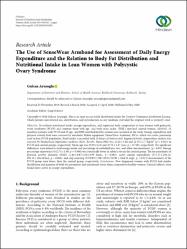| dc.contributor.author | Arusoğlu, Gülcan | |
| dc.date.accessioned | 2021-12-12T17:02:58Z | |
| dc.date.available | 2021-12-12T17:02:58Z | |
| dc.date.issued | 2020 | |
| dc.identifier.issn | 2090-0724 | |
| dc.identifier.issn | 2090-0732 | |
| dc.identifier.uri | https://doi.org/10.1155/2020/9191505 | |
| dc.identifier.uri | https://hdl.handle.net/20.500.11857/3580 | |
| dc.description.abstract | Objective. To evaluate nutritional intake, energy expenditure, and segmental body composition in lean women with polycystic ovary syndrome (PCOS) and compare them with age- and body mass index- (BMI-) matched control women. Methods. 32 nonobese patients with PCOS and 31 age- and BMI-matched healthy women were included in the study. Energy expenditure and physical activity level were assessed by metabolic Holter equipment (SenseWear Armband, SWA) which was never previously used in lean PCOS population. Food intake is recorded with 24 hours of food record. Segmental body composition analysis was assessed by bioelectrical impedance analyses (BIA). Results. Mean BMI was 22.64 +/- 3.64 and 21.55 +/- 2.77 kg/m(2) (p=0.185) in PCOS and control groups, respectively. Mean age was 22.03 +/- 4.21 and 21.71 +/- 2.67 year (p=0.720), respectively. No significant differences were found in total energy intake and percentage of carbohydrates, fats, and other micronutrients (p>0.05). Energy percentage of proteins (%12.73 +/- 1.98, p=0.008) was statistically lower in subjects versus the control group. The measurements of physical activity duration (PAD) (1.40 +/- 0.87/2.18 +/- 0.99 hours, p=0.002), active energy expenditure (372.35 +/- 198.32/494.10 +/- 186.50 kcal, p=0.018), and step counting (9370.03 +/- 3587.49/11730.90 +/- 3564.31 steps, p=0.013) measurement of the PCOS group were lower than the control group, respectively. Conclusions. New diagnosed women with PCOS had similar distribution and quantity of body fat parameters and nutritional status when compared to healthy women. Control subjects were found more active in energy expenditure. | en_US |
| dc.language.iso | eng | en_US |
| dc.publisher | Hindawi Ltd | en_US |
| dc.relation.ispartof | Journal of Nutrition and Metabolism | en_US |
| dc.identifier.doi | 10.1155/2020/9191505 | |
| dc.rights | info:eu-repo/semantics/openAccess | en_US |
| dc.subject | Physical-Activity | en_US |
| dc.subject | Individuals | en_US |
| dc.subject | Patterns | en_US |
| dc.title | The Use of SenseWear Armband for Assessment of Daily Energy Expenditure and the Relation to Body Fat Distribution and Nutritional Intake in Lean Women with Polycystic Ovary Syndrome | en_US |
| dc.type | article | |
| dc.authorid | Arusoglu, Gulcan/0000-0002-9676-0025 | |
| dc.department | Fakülteler, Sağlık Bilimleri Fakültesi, Beslenme ve Diyetetik Bölümü | |
| dc.identifier.volume | 2020 | en_US |
| dc.relation.publicationcategory | Makale - Uluslararası Hakemli Dergi - Kurum Öğretim Elemanı | en_US |
| dc.authorscopusid | 25930698400 | |
| dc.identifier.wos | WOS:000536852900001 | en_US |
| dc.identifier.scopus | 2-s2.0-85085291879 | en_US |
| dc.identifier.pmid | PubMed: 32455003 | en_US |
| dc.institutionauthor | Arusoğlu, Gülcan | |



















